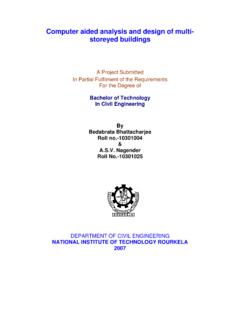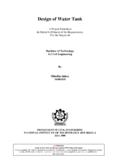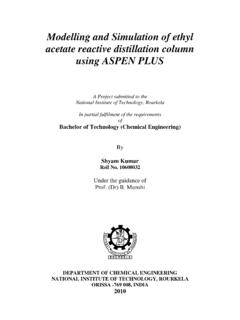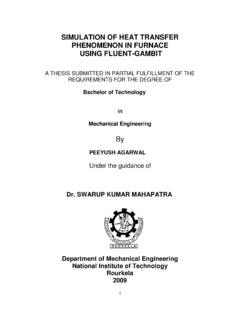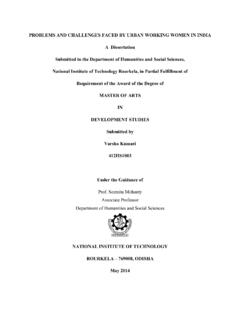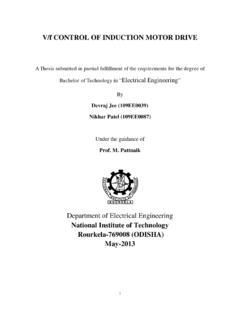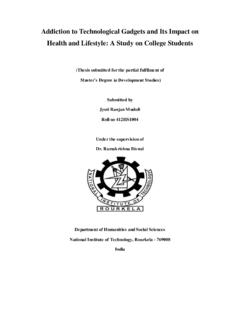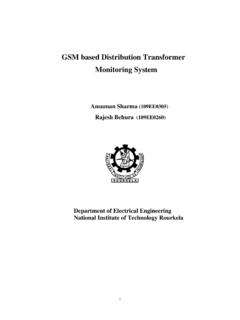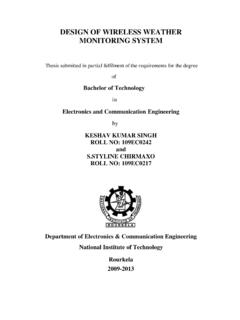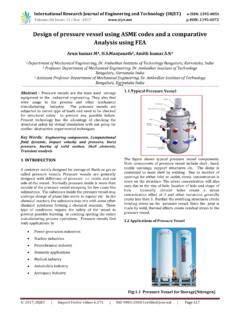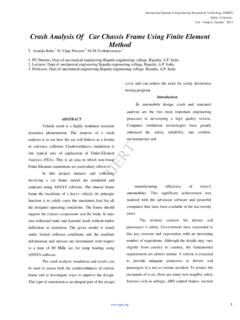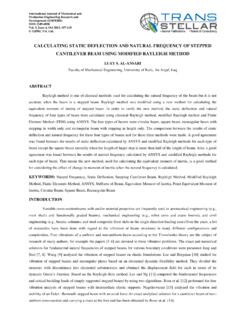Transcription of Design and Analysis of Laminated Composite Materials
1 0 Design and Analysis of Laminated Composite Materials Thesis submitted in partial fulfillment of the requirements for the Degree of Bachelor of Technology (B. Tech.) In Mechanical Engineering By BHAGYASHREE SUNA Roll No. 110ME0335 Under the Guidance of Prof. J. Srinivas NATIONAL INSTITUTE OF TECHNOLOGY ROURKELA 769008, INDIA 1 NATIONAL INSTITUTE OF TECHNOLOGY ROURKELA 769008, INDIA Certificate of Approval This is to certify that the thesis entitled Design and Analysis of Laminated Composite Materials submitted by Miss Bhagyashree Suna has been carried out under my supervision in partial fulfillment of the requirements for the Degree of Bachelor of Technology in Mechanical Engineering at National Institute of Technology, NIT Rourkela, and this work has not been submitted elsewhere before for any other academic degree/diploma.
2 ---------------------------------------- -- Dr. J. Srinivas Associate Professor Department of Mechanical Engineering National Institute of Technology, Rourkela Rourkela-769008 Date: 2 Acknowledgement I would like to express my deep sense of gratitude and indebtedness to Dr.
3 J. Srinivas, Associate Professor, Department of Mechanical Engineering, NIT Rourkela, my supervisor, whose invaluable encouragement, suggestions, and support leads to make successful completion of the thesis work. His meticulous guidance at each phase of this thesis has inspired and helped me innumerable ways. I would also like to show my sincere thanks to Prof. K. P. Maity, Professor and Head of the Department, Mechanical Engineering; I offer my thanks to all my friends and especially those involved in helping me to give basic ideas in writing graphic user interfaces and use of ansys software in Laminated Composite Analysis .
4 I am grateful to my parents and all my teachers who indirectly helped me through-out. Bhagyashree Suna 3 Abstract Composite Materials have interesting properties such as high strength to weight ratio, ease of fabrication, good electrical and thermal properties compared to metals. A Laminated Composite material consists of several layers of a Composite mixture consisting of matrix and fibers. Each layer may have similar or dissimilar material properties with different fiber orientations under varying stacking sequence.
5 There are many open issues relating to Design of these Laminated composites. Design engineer must consider several alternatives such as best stacking sequence, optimum fiber angles in each layer as well as number of layers itself based on criteria such as achieving highest natural frequency or largest buckling loads of such structure. Analysis of such Composite Materials starts with estimation of resultant material properties. Both classical theory and numerical methods such as finite element modeling may be employed in this line.
6 Further, these estimated properties are to be used for computing the dynamic properties of the members made-up of these Materials as equivalent isotropic members. At this level, a Graphic User Interface (GUI) device is developed with MATLAB programming to interactively create a user friendly environment for computing overall material properties using classical laminate theory. User can enter the number of layers and layer orthotropic properties and the back end program calculates the extension, bending and coupling stiffness matrices and further it estimates the overall elastic constants, Poisson ratios and density.
7 The result will be displayed in the front end interface boxes. The obtained constants are validated with an ansys model, where the laminate stacking sequence is built and the member is subjected to a uniform strain at free end, while the reaction stress at the fixed end is predicted. The developed interface simplifies the Design process to some extent. The dynamic Analysis in terms of fundamental natural frequency and critical buckling load is illustrated by using these overall material constants as a later part of Analysis .
8 4 Contents Content Page Laminated Composite Structures Literature Review Objectives 5 7 14 2. Mathematical Modeling Generalized Hook s Law 16 Force, moment relations 17 Effective elastic constants 19 FEM of Laminated Composite Dynamic Analysis 21 23 3.
9 Methodology Development of GUI Overall material properties using ansys Calculation of natural frequencies 26 27 29 4. Results & Discussion Graphical User Interface (GUI) functionality Development of finite element model in ansys Natural frequencies and Critical Buckling loads 30 32 34 5. Conclusions 35 References Appendix-A MATLAB program developed Appendix-B Use of Shell elements in ansys 36 39 50 5 Chapter 1 Introduction Laminated Composite Materials are extensively used in aerospace, defense, marine, automobile, and many other industries.
10 They are generally lighter and stiffer than other structural Materials . A Laminated Composite material consists of several layers of a Composite mixture consisting of matrix and fibers. Each layer may have similar or dissimilar material properties with different fiber orientations under varying stacking sequence. Because, Composite Materials are produced in many combinations and forms, the Design engineer must consider many Design alternatives. It is essential to know the dynamic and buckling characteristics of such structures subjected to dynamic loads in complex environmental conditions.
